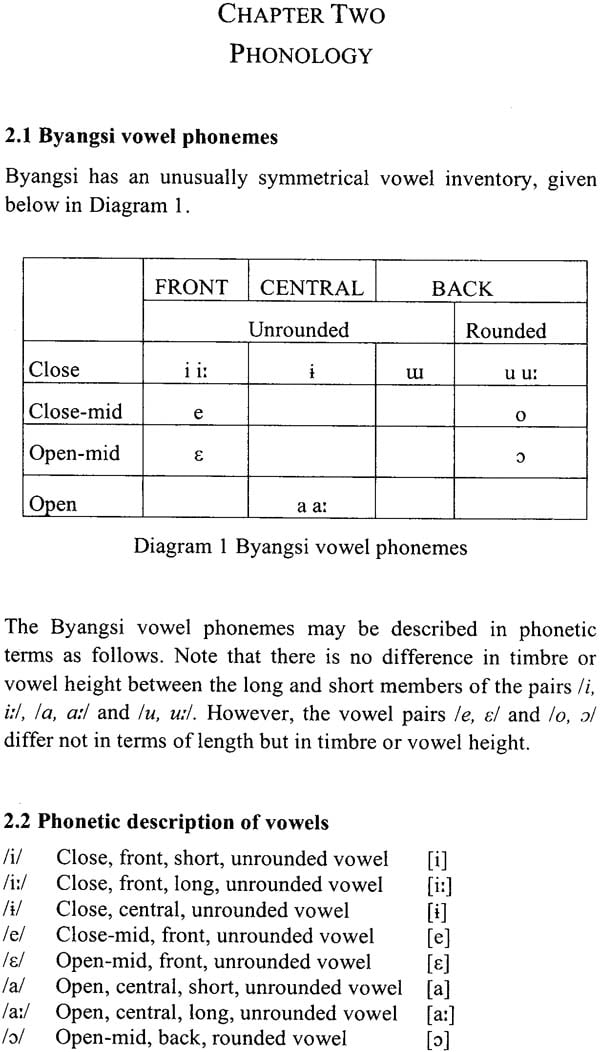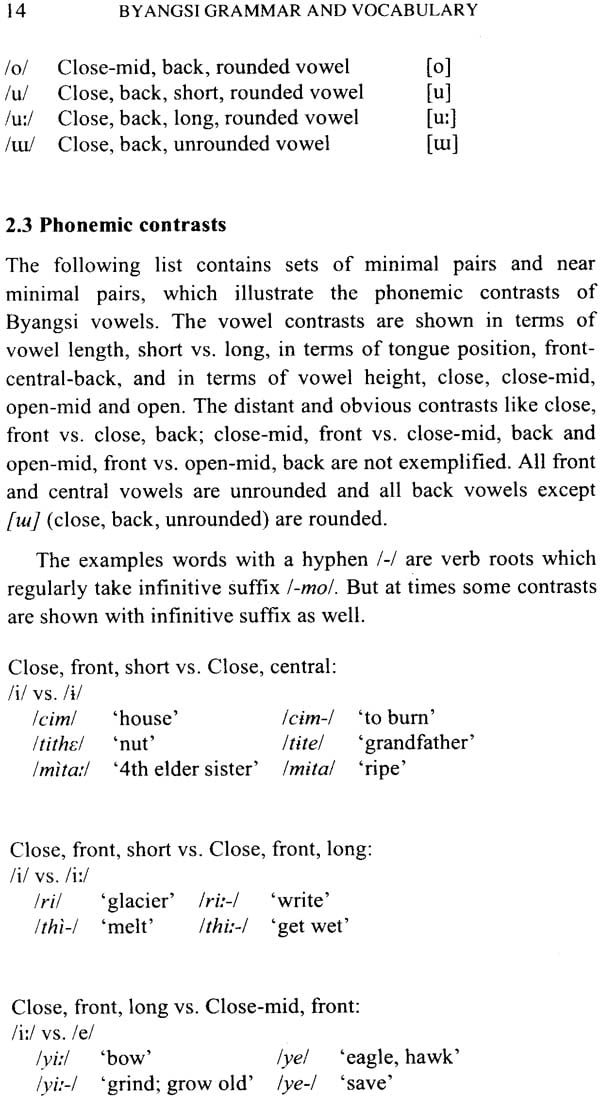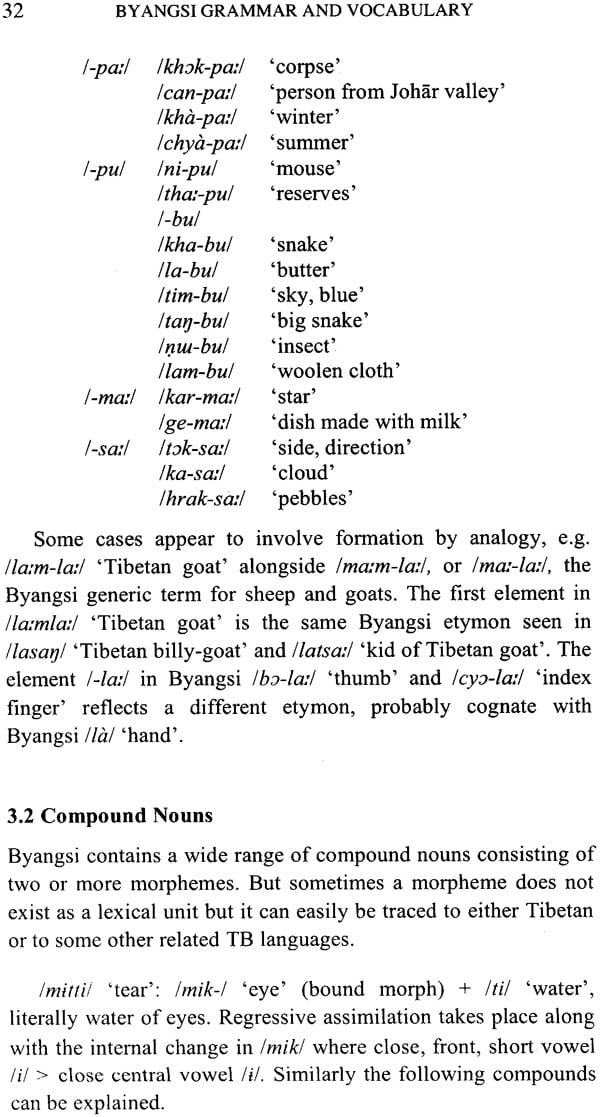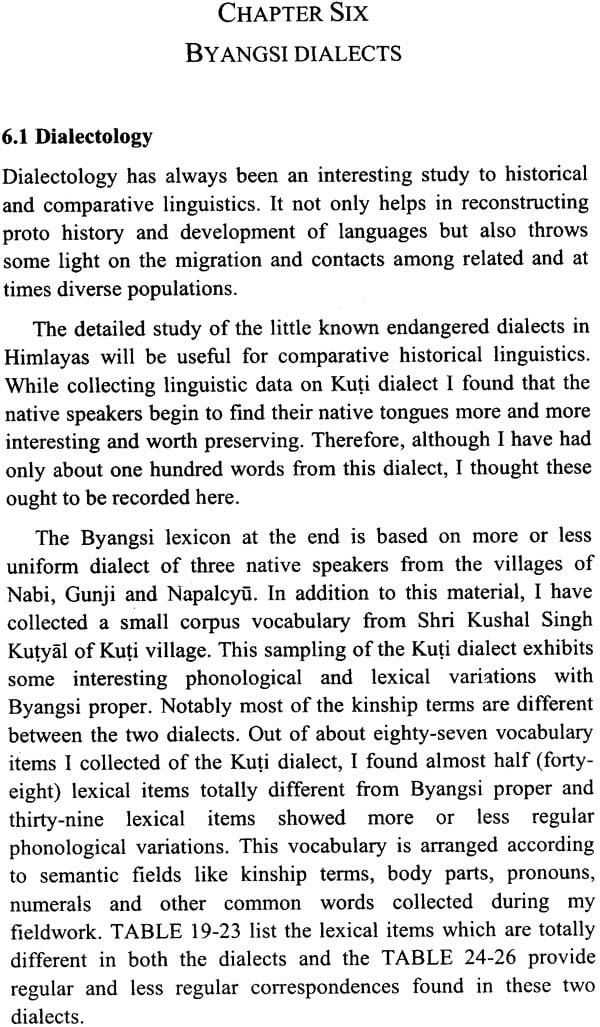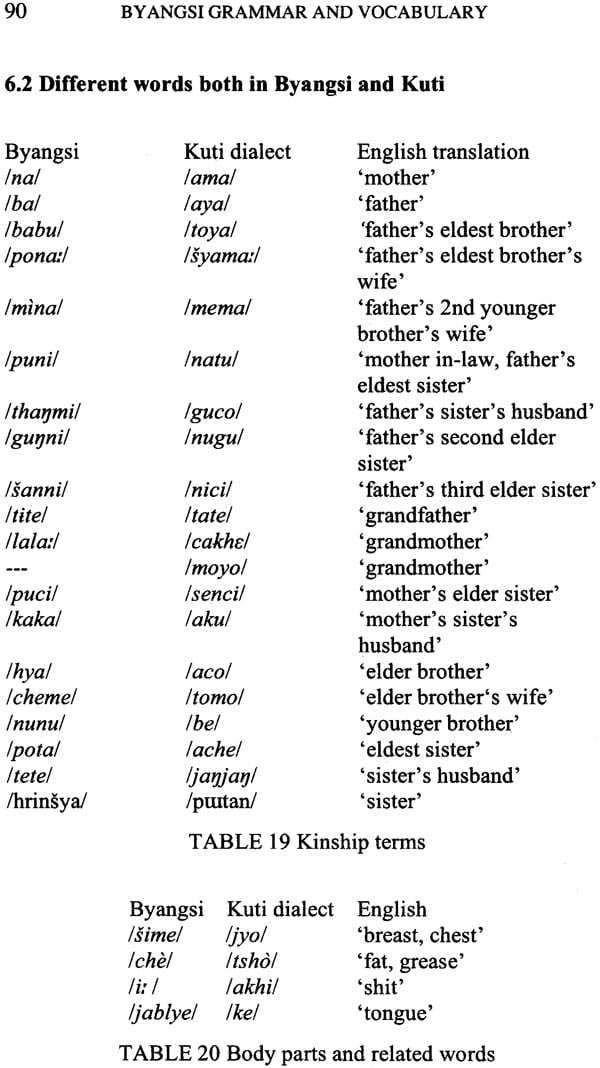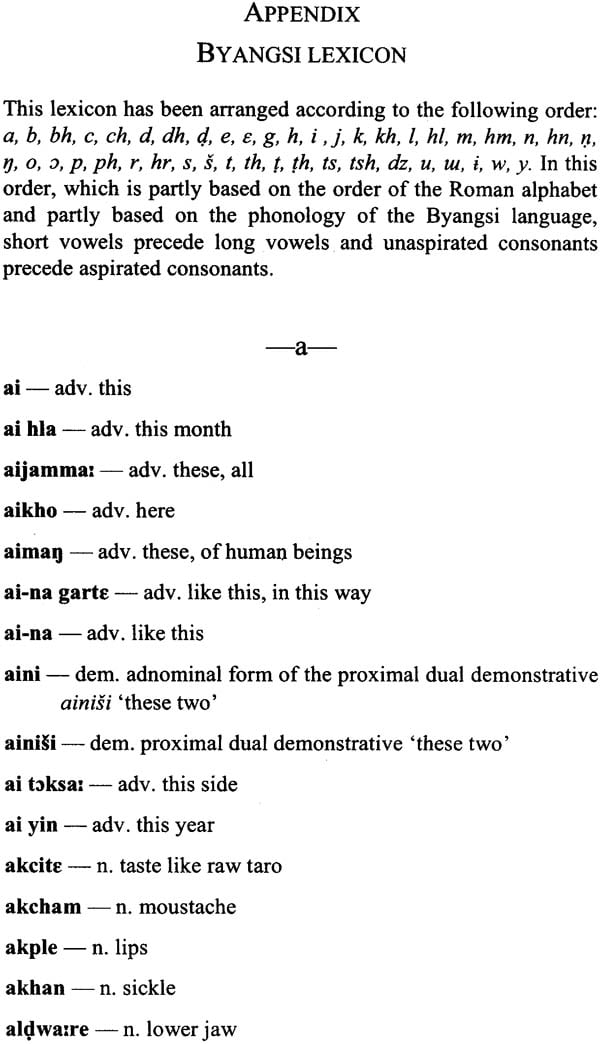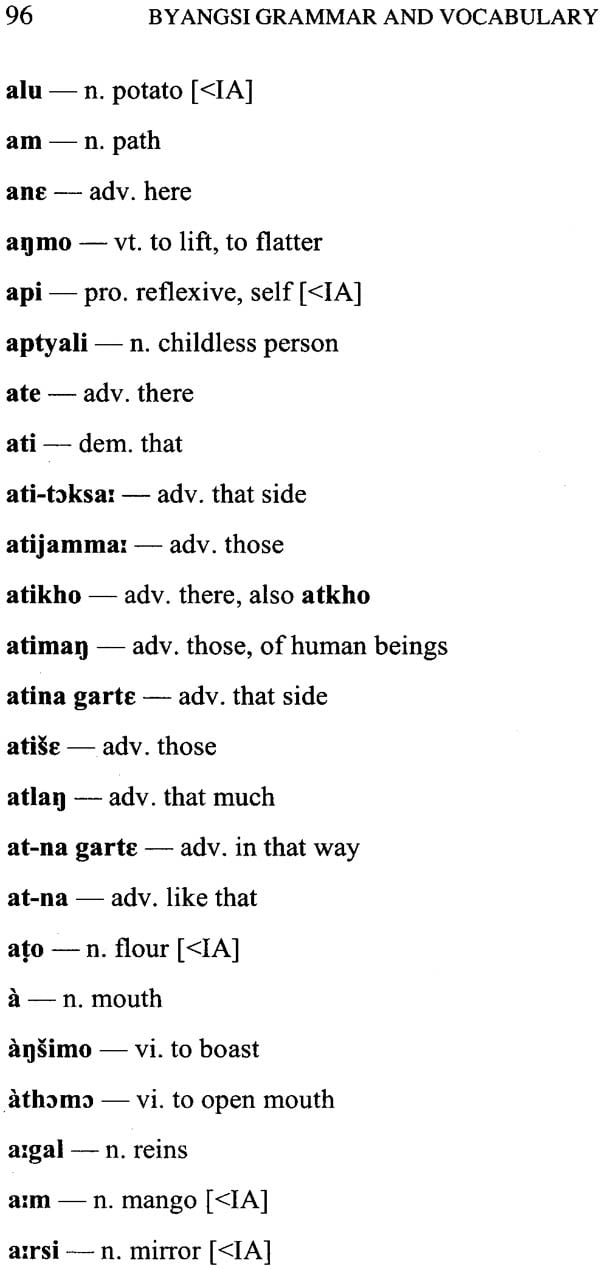
Byangsi Grammar and Vocabulary
Book Specification
| Item Code: | NAM205 |
| Author: | Suhnu Ram Sharma |
| Publisher: | Deccan College Postgraduate and Research Institute |
| Language: | English |
| Edition: | 2007 |
| Pages: | 169 |
| Cover: | Paperback |
| Other Details | 9.0 inch X 6.0 inch |
| Weight | 230 gm |
Book Description
The Department of Linguistics at the Deccan College has the double distinction of inspiring the introduction of linguistics in the university curriculum in India and undertaking actual field studies of languages belonging to all the four language families of the country. Arising from these field studies spanning the last 60 years, the Institute brought out a large number of monographs and reports. The present monograph by Professor Suhnu Ram Sharma on one of the Tibeto-Burman languages being spoken in the remote areas of Western Himalayas is our latest addition to this list.
Professor Sharma deserves full credit and rich compliments for successfully accepting the challenge of collecting a specific type of language data from the speakers of Byangsi living in a truly remote part of Western Himalayas.
This monograph provides a short linguistic description of Byangsi language being spoken in remote parts of Pithauragarh district of the newly formed state of Uttaranchal. The Tibeto-Burman languages spoken in the western Himalayas are considered as endangered languages since small populations speak these languages and the medium of communication outside home and hearth is quite different from their mother tongues. Therefore the documentation and study of these languages assumes a large measure of importance.
The first part of the monograph provides useful general information on the Tibeto-Burman languages of this area. It is followed by phonological analysis, providing system of vowels, consonants and tones. Later sections describe the grammar of Byangsi language, i.e. nouns, pronouns, adjectives, numerals, verbs and adverbs. Grammatical categories like number, person, gender, case, tense, aspect and mood are described. A section towards the end gives some useful dialect data from Kuti village with comparable forms from Byangsi language. Appendix includes vocabulary with English glosses.
I am sure that research workers specializing in comparative- historical and typological studies will find the monograph very useful. I deeply appreciate Professor Sharma's gesture of dedicating this monograph to the memory of Prof. S.M. Katre, who is regarded as the father of modern linguistics in India
1.1 The Byangsi and their Tibeto-Burman (TB) neighbours
Byangsi, locally pronounced as /bydsi/, is one of seven Tibeto- Burman languages that are reported by Grierson (1909) as being spoken in the Himalayas and sub- Himalayas between the Gangetic Plain and the Tibetan Plateau, in the areas traditionally known as Kumau and Garhwal, Together with some other hill districts, Kumau and Garhwal now form the state known as Uttranchal, which formerly was part of the state of Uttar Pradesh. Uttranchal is situated to the immediate west of Nepal and to the east of the state of Himachal Pradesh in the Indian Republic. Currently, the eastern area Kumau is divided into three districts, Almora, Nainital and Pithauragarh, whereas the western area known as Garhwal is divided into five districts, Dehradun, Uttarkashi, Chamoli, Tihari-Garhwal and Pauri-Garhwal.
1.2 Family Affiliation
Sten Konow in Grierson's Linguistic Survey of India (1909) classified all the Tibeto-Burman languages spoken in Uttranchal except Jad under western sub-group of pronominalized Himalayan group of Tibeto-Himalayan branch of Tibeto-Burman sub-family. Byangsi along with Chaudangsi, Darma, Janggali and some other languages of the western Himalayas was grouped under the pronominalized group due its distinctive morphological structure where a pronominal element is incorporated in the verbal complex. Robert Shafer (1955) placed these languages under his Almora branch of Bodic division of Sino-Tibetan family of languages. Paul K. Benedict (1972) classified the above languages under his Tibeto-Kinnauri division of Sino-Tibetan family. Currently (George van Driem: 2001) the most accepted family name is Tibeto-Burman but sub- grouping of many Himalayan languages remains to be settled due the paucity of detailed linguistic descriptions. Although pronominalization is a distinctive feature of most of the languages of the western Himalayas, yet the precise details of each one are not fully understood (Suhnu Ram Sharma: 1996).
Below, I provide a bird's eye view of the Tibeto-Burman languages of Uttaranchal. Almost as if we are reading a map from left to right, our flight takes us eastwards across these mountainous tracts and terminates in the Byangsi-speaking area where we land to take a closer look. I am careful to distinguish Hindi names from autonyms, i.e. native self-designations of the people, and names that were given to the people and the languages of this region by other scholars and researchers. In addition to the commonly used but often simplified Anglicized forms, more precise notations are provided, which I should like to propose as standard English language designations for the Tibeto-Burman languages of this region. In the government records, all the Tibeto-Burman speaking people in this region are regarded as belonging to the scheduled tribe called Bhutiya, sometimes Bhotiya except for the Raji tribe.
The Byangsi description presented here is based on my fieldwork investigations in the winter of 1991-1992 in Dharcula (in Nepal, it is pronounced as - Darcula) the results of which were previously published in an article, ‘A sketch of Byangsi Grammar' (2001:271-341) as well as on supplementary field work during the summers of 2002 and 2003. The present work also includes analysed text with English translation and a list of eighty seven words from a dialect of Byangsi spoken in Kuti village located at the end of in /Byas/ valley, near the Tibetan border. This list although a short one will be very useful for comparative historical research work in future. The similarities and the differences between these dialects are discussed in chapter six.
1.3 Jad
Of the seven languages mentioned by Grierson, two are spoken in Garhwal, i.e. Jad and Rongpo. Jad is spoken in Bagora village, about three kilometres south of the Harsil sub-division (Harsil Tehsil) and in the Dunda village, only seventeen kilometres south of Uttarkashi proper, on the banks of the Bhagirathi, where the Jad were resettled after the Indo-Chinese conflict of 1962. Some settlements of Jad are also found in the Purola, Rajgarhi, and Bhatwari sub-divisions. The original home of the Jad lies on the Indo- Tibetan border, in the Jadang and Nilang villages in the Harsil subdivision in the north of Uttarkashi. In the summer, the Jad still return with their flocks to their original homeland. The name Jad seems to derive from the village name Jadang. The Hindi toponym Jad with a retroflex final /d/ is pronounced by the Jad themselves with a voiced alveolar plosive final /d/. Some two thousand Jad were reported to the 1991 village census. Linguistic data on Jad are available in Grierson (1909, III, 1:9 1- 92), who considered the language 'closely related to the Tibetan spoken in Spiti' of Himachal Pradesh. Some later linguistic data have been presented by D.D. Sharma (1990:1-78.). The present author with the experience of working on Spiti (1979:83-89) concurs with Grierson's analysis and is of the opinion that Jad language is related to dialects of Tibetan.
1.4 Rongpo/ Rangpo
Rongpo, which is sometimes pronounced as Rangpo /ranpo/ is, spoken in the Niti and Mana valleys in the Joshimath sub- division of Chamoli district, north of Badrinath. The Niti valley dialect is known as Tolcha /tolcha:/, and the Mana valley dialect, which is also spoken in the lower portion of the Niti valley, is known as Marcha [marcha:]. Both of the latter designations are felt to be pejorative by the Rongpo. The word [marcha:] is analysed and translated by older informants as, /mhar/ 'butter' and /cha:/ 'salt' and was apparently applied to the Rongpo because in the past they used to sell butter and salt. They used to carry salt and tea-leaves from India to Tibet and from Tibet they used to bring butter, dry cheese and wool and sell in India. Grierson referred to the Rongpo dialect as the 'Garhwal dialect' of Tibetan, and found it 'closely related to the forms of Tibetan spoken by the Jads of Tehri Garhwal' (1909, Ill, 1:100). Claus Peter Zoller (1983) calls the language, 'Die Sprache Der Rang Pas Von Garhwal' in German, and for the indigenous name he records the hybrid '/Ran P Po Bhasa/', However, the correct native ethnonym, is /ranpo/, indianized as Rongpo /ronpo/ in day-to-day conversations. According to the 1991 village census the Rongpo population is twelve thousand. In wintertime, some of the Rongpo take their flocks and cattle to an area near Gopeshwar in Chamoli and in the summer they move to their native land in the Niti and Mana valleys. Since the Indo-Chinese conflict of 1962, the Rongpo have increasingly begun to abandon the practice of seasonal migrations.
Claus Peter Zoller has described Rongpo /ronpo/ as ‘keine pronominalisierte Sprache’ and as ‘keine Tonsprache' (Zoller 1983: xxix), but he is wrong on both these counts (S.R. Sharma 1996, 2001). Rongpo is definitely a pronominalized language and its conjugational morphology similar to that of the Rang languages spoken in Pithauragarh (Byangsi, Chaudangsi and Darma), to which it appears to be closely related. Although the small language communities in Pithauragarh are separated by high mountains and have no regular day to day contact, they still maintain the common name Rang /ran- ron/ for the Rongpo and Rang /ran-ron/, for the Rongpo and Rang /ran/, which is used as generic term for the Rangkas, Darma, Chaudangsi and Byangsi. All five of these groups have special enthonyms in their own languages to designate and distinguish each other. D.D. Sharma (1990) provides a brief description of 'Marchha', which he claims 'widely differs from' Jad. My own description of the Marcha /marcha:/ dialect under the name Rongpo (S.R. Sharma, 2001:195-370) is based on the data collected from the speakers settled at the village of Chinka near Chamoli proper, only few of which continue to visit their uphill villages in the Niti and Mana valleys during the summer. The Tolcha /tolcha:/ dialect has yet to be described. My Rongpo consultants claimed that they can easily understand the dialect known as Tolcha, but they prefer to associate themselves with the generic name Rang, or Rongpo, as do the Marcha people.
1.5 Raji
Of the seven Tibeto-Burman languages of Uttaranchal, five are spoken in Kumau. One of these is the Raji language, which Grierson (1909, Ill, 1: 530) referred to as 'Janggali' meaning 'jungle dwellers'. The Raji are still referred to as Janggali by locals nowadays. The equally pejorative terms Ban-Ravat or Ban-Khaniya-Ravat meaning- forest kings or forest dwellers also refer them to. The more neutral Hindi-Nepali term Raji /raji/ ‘regal’ has now been adopted to designate these people, who until recent times confined themselves, mainly to the deep forests. According to a census conducted by development officers in 1988, the total number of Raji in Pithauragarh district was 472. These Raji people based in four villages in the Dharciila sub-division, four village in the Didihat sub-division and one village in the Campawat sub-division. The Raji speakers are also found in the Nepalese Terai, where they still lead a nomadic life.
Grierson (1909, Ill, 1: 535-566) listed a little over 240 words and phrases under the name Janggali. Shobharam Sharma (1986) wrote an article in Hindi in which he described some features of the Raji language. D.D. Sharma (1990: 169-228) published a 'description' of Raji, which was based exclusively on the article by Shobharam Sharma. A more detailed treatment of Raji is provided by Shree Krishan (2001 :449-487).
| Contents | vii | |
| List of Diagrams and Tables | x | |
| Abbreviations and Symbols | xi | |
| Acknowledgements | xiii | |
| Foreword | xv | |
| Chapter One : Introduction | 1 | |
| 1 | The Byangsi and their TB neighbours | 1 |
| 1.2 | Family Affiliation | 1 |
| 1.3 | Jad | 3 |
| 1.4 | Rongpo/Rangpo | 3 |
| 1.5 | Raji | 5 |
| 1.6 | Rangkas | 5 |
| 1.7 | Darma | 7 |
| 1.8 | Chaudangni | 7 |
| 1.9 | Byangsi | 8 |
| 1.10 | Sociolinguistic Background | 10 |
| 1.11 | The Present Study | 11 |
| Chapter Two: Phonology | 13 | |
| 2.1 | Byangsi vowel phonemes | 13 |
| 2.2 | Phonetic description of vowels | 13 |
| 2.3 | Phonemic contrast | 14 |
| 2.4 | Phonotactic co-occurrences of vowels | 17 |
| 2.5 | Byangsi tones | 18 |
| 2.5.1 | Tonal contrasts between level tone and falling tone | 19 |
| 2.5.2 | Tonal contrasts between level tone and rising tone | 19 |
| 2.5.3 | Tonal contrasts between falling tone and rising tone | 20 |
| 2.6 | Nasalization | 20 |
| 2.7 | Syllable types | 22 |
| 2.8 | Byangsi consonant phonemes | 22 |
| 2.9 | Phonetic description of consonant phonemes | 23 |
| 2.10 | Consonant contrasts | 25 |
| 2.11 | Consonant clusters | 28 |
| Chapter Three: Nominal Morphology | 31 | |
| 3.1 | Nouns and some derivational morphology | 31 |
| 3.2 | Compound Nouns | 32 |
| 3.3 | Gender | 33 |
| 3.4 | Number | 35 |
| 3.5 | Personal pronouns | 36 |
| 3.6 | Demonstrative pronouns | 36 |
| 3.7 | Interrogative and indefinite pronouns | 38 |
| 3.8 | Reflexive pronouns | 40 |
| 3.9 | Case | 40 |
| 3.10 | Postpositions | 45 |
| 3.11 | Adjectives | 48 |
| 3.12 | Numerals | 50 |
| Chapter Four: Verbal Morphology | 53 | |
| 4.1 | Verb stems and the infinitive | 53 |
| 4.2 | Compound steam | 53 |
| 4.3 | The infinitive forms | 54 |
| 4.4 | Indicative mood and the agreement system | 55 |
| 4.5 | Aspectivizers and mediopassive stems formative/-si/ | 59 |
| 4.6 | The imperative | 63 |
| 4.7 | The subjunctive and adhortative | 66 |
| 4.8 | Gerunds | 67 |
| 4.9 | Reflexes of the TB transistorizing */s-/ prefix | 69 |
| 4.10 | Present active participles | 69 |
| 4.11 | Adverbs | 71 |
| Chapter Five: Syntax and Sample Text | 75 | |
| 5.1 | Syntactic element order | 75 |
| 5.2 | Relative clauses | 77 |
| 5.3 | Byangsi Text Specimen | 79 |
| Chapter Six: Byangsi Dialects | 89 | |
| 6.1 | Dialectology | 89 |
| 6.2 | Different words both in Byangsi and Kuti | 90 |
| 6.3 | Regular or less Regular Correspondences | 92 |
| Appendix: Byangsi Lexicon | 95 | |
| References and Bibliography | 149 |
Sample Pages
